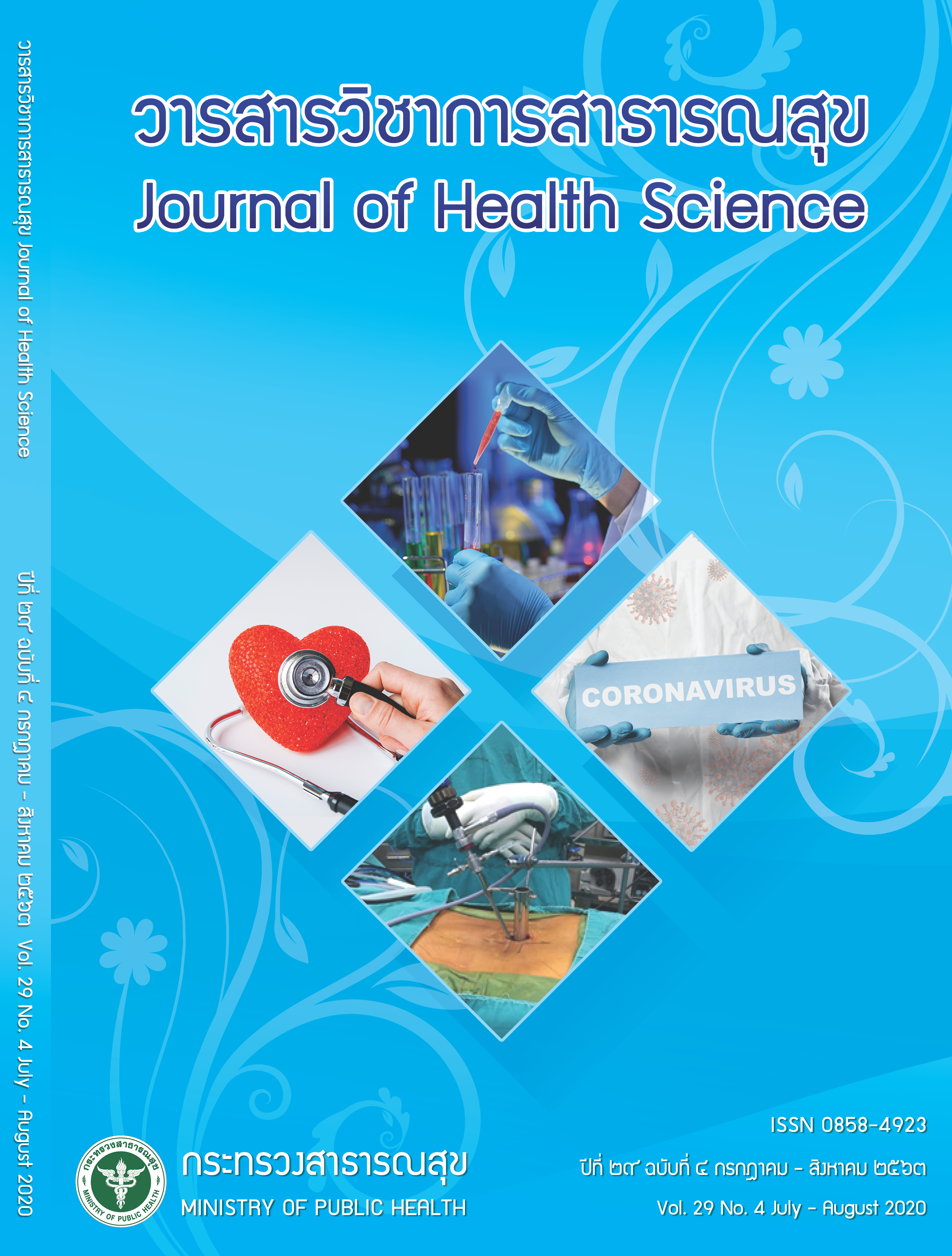Clinical Manifestations and Epidemiology of Leptospirosis Cases, Upper Southern Thailand, 2017
Keywords:
leptospirosis, outbreak, flooding, upper Southern ThailandAbstract
Upper Southern Thailand experienced widespread flash floods in January 2017. The number of suspected cases of leptospirosis increased sharply in Nakhon Si Thammarat and Krabi provinces; and 5 fatal cases were reported. The objective of this study was to conduct an outbreak investigation with the aims to confirm diagnosis with outbreak, describe confirm diagnosis and outbreak of leptospirosis after the flood, to study of clinical manifestations, epidemiological and risk behaviors of patients, and to recommend about diagnostic guidelines, control and prevention measures. It was conducted as a descriptive study. In active case finding, a suspected case was defined as the persons who lived in Nakhon-Si-thammarat and Krabi province, had fever and two of the following symptoms: headache, myalgia, calf pain and jaundice during 6 January – 12 February 2017. Data were collected from the record of patient interview on risk behavior and laboratory results. A lab-confirmed case was defined as having positive test of either PCR or IFA or MAT or ELISA. Environmental and domestic animals reservoirs study was performed for Leptospira PCR and culture including MAT for leptospira serology. It was found that a total of 151 cases met the case definition (with 5 deaths, giving case fatality rate of 3.3%); 89 cases from Nakhon-Si-thammarat, and 62 cases from Krabi. Among them, 30.5% were lab-confirmed and 13.9% and 55.6% were probable and suspected cases. The median age was 40 years (range 7, 80), agriculture 66.22%. The onset of first patient was on 6 January 2017. The highest number of patients was found in the 3rd week after flooding. Common clinical presentations were fever (98.7%), myalgia (81.3%) and headache (78.1%); and 48.8% of the confirmed cases were tested positive by rapid test. CBC test abnormalities were observed: platelet 34.2%, WBC 25.7%, hematocrit 33.1%, neutrophil 37.8%, lymphocyte 33.1%, monocyte 21.0% and eosinophil 18.2%. Renal function tests: BUN and creatinine were high in 83.2% and 79.1% of cases, respectively; and liver function tests: albumin, globulin, total bilirubin, direct bilirubin, AST, ALT and ALP were high in 85.1%, 37.2%, 79.1%, 75.7%, 61.1%, 50.2% and 40.5% of the cases, respectively. Behaviors risk was common among cases demonstrated that exposure with water and mud (96.9%), unprotected boots (84.4%) and contacted with water more than 6 hour (81.3%). Serovar Shermani was the most common strain in both patients and animals; and leptospira was found in the patient’s home soil. In conclusion, the laboratory results confirmed the occurrence leptospirosis outbreak in the areas following the severe flash floods. Behavior of patients linked to the disease. CBC findings were normal in most patients. However, liver or kidney disorders were common. The team set-up a special surveillance system after the flood. It is recommended that physicians supervise patients in the area by using clinical signs and history of risk with rapid test results for immediate diagnosis and treatment to reduce mortality of the disease.
Downloads
References
ยุพิน ศุพุทธมงคล, ปัทมา เอกโพธิ์, พิมพ์ใจ นัยโกวิท, พลายยงค์ สการะเศรณี, รัตนา ธีระวัฒน์. คู่มือวิชาการ โรคเลปโตสไปโรสิส. พิมพ์ครั้งที่ 2. กรุงเทพมหานคร: ชุมนุมสหกรณ์-การเกษตรแห่งประเทศไทย; 2558.
ดิเรก สุดแดน, วราลักษณ์ ตังคณะกุล, มนูศิลป์ ศิริมาตย์, นิคม สุนทร, ไพบูลย์ทนันไชย, สลักจิต ชุติพงษ์วิเวท, และคณะ.ปัจจัยที่มีผลต่อการเป็นโรคฉี่หนูหลังจากอุทกภัยครั้งใหญ่จังหวัดน่าน สิงหาคม - กันยายน ปี 2549. รายงานการเฝ้าระวังทางระบาดวิทยาประจำสัปดาห์ 2551;39:162-5.
ดิเรก สุดแดน, ถนอม น้อยหมอ, วราลักษณ์ ตังคณะกุล, มนูศิลป์ ศิริมาตย์, ไพบูลย์ทนันไชย, สลักจิต ชุติพงษ์วิเวท และคณะ. การระบาดครั้งใหญ่ที่สุดของโรคฉี่หนูในประเทศไทย จากอุทกภัย เดือนสิงหาคม - กันยายน 2549. รายงานการเฝ้าระวังทางระบาดวิทยาประจำสัปดาห์ 2550;38:885-90.
ศูนย์วิทยาศาสตร์การแพทย์ที่ 12 จังหวัดสงขลา. ซีโรกรุ๊ปของเชื้อเลปโตสไปราที่ระบาดในพื้นที่จังหวัดสงขลาหลังน้ำท่วม ปี 2553 [อินเทอร์เน็ต]. [สืบค้นเมื่อ 22 ส.ค. 2560]. แหล่งข้อมูล: http://www.rmscsongkhla.go.th/document
สำนักงานป้องกันควบคุมโรคที่ 11 จังหวัดนครศรีธรรมราช. สถานการณ์โรคเลปโตสไปโรสิสในพื้นที่ภาคใต้ตอนบน ปี 2560. นครศรีธรรมราช: สำนักงานป้ องกันควบคุมโรคที่ 11; 2560.
Gamage CD, Tamashiro H, Ohnishi M, Koizumi N. Epidemiology, surveillance and laboratory diagnosis of Llptospirosis in the WHO South-East Asia Region. Intech Open [Internet]. [cited 2017Aug 22]. Available from: https://www.intechopen.com/books/zoonosis/epidemi-ology-surveillance-and-laboratory-diagnosis-of-lepto-spirosis-in-the-who-south-east-asia-regio
ดาริกา กิ่งเนตร. คู่มือวิชาการโรคเลปโตสไปโรซิส. นนทบุรี: กรมควบคุมโรคติดต่อ; 2543.
สุรชัย จิตต์ดำรงค์, เอนก มุ่งอ้อมกลาง, เอมอร ไชยมงคล, ดวงใจ สุวรรณ์เจริญ, วราลักษณ์ ตังคณะกุล. การระบาดของโรคเลปโตสไปโรสิสในกลุ่มนักท่องเที่ยวชาวไทยในการท่องเที่ยวเชิงนิเวศน์ในอำเภอละงู จังหวัดสตูล พ.ศ. 2550. วารสารวิชาการสาธารณสุข 2554;20(ฉบับเพิ่มเติมที่ 1): 104-14.
Daher EF, LimaI RSA, Silva Júnior GB, Silva EC, Kar-bage NNN, Kataoka RS, et al. Clinical presentation of leptospirosis: a retrospective study of 201 patients in a metropolitan city of Brazil. Braz J Infect Dis 2010; 14(1):3-10.
Dupont H, Dupont-Perdrizet D, Perie JL, Zehner-Han-sen S, Jarrige B, Daijardin JB. Leptospirosis: prognostic factors associated with mortality. Clin Infect Dis 1997;25(3):720–24.
Downloads
Published
How to Cite
Issue
Section
License

This work is licensed under a Creative Commons Attribution-NonCommercial-NoDerivatives 4.0 International License.







